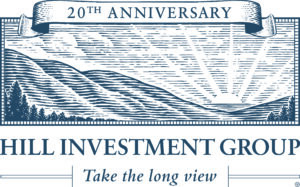Details Are Part of Our Difference
David Booth on How to Choose an Advisor
20 Years. 20 Lessons. Still Taking the Long View.
Making the Short List: Citywire Highlights Our Research-Driven Approach
The Tax Law Changed. Our Approach Hasn’t.
Category: Featured
Introducing Griffin Lewis

We’re excited to introduce the newest member of our team, Griffin Lewis, a proud University of Texas graduate (like two of his teammates here at HIG). In the past, we prioritized hiring by location. Today, we focus on finding the best possible person for the role: people whose values match our own. That’s true across the board, from full-time team members to interns. Though we differ in many ways, the qualities we share—being old souls, a connection to the outdoors, joy in serving others, and a deep commitment to our craft—make us, in short, a team of caring nerds.
Griffin embodies these traits fully. You will see him jumping in wherever he’s needed—whether that’s supporting service, trading, or operations—so that you experience seamless care from our entire team. His “utility player” mindset means he’s always looking for ways to make your life easier.
Shaped by a family that taught him resilience, inspired by a sister who set a high bar early on, and sharpened by experiences as both a behind-the-scenes problem solver and a door-knocking entrepreneur, Griffin brings both grit and heart to our work. Outside the office, you’ll likely find him logging long runs or cycling laps around Lady Bird Lake, or chasing down sunrises and spontaneous adventures.
We’re thrilled for you to get to know him. Are you a “caring nerd?” or do you know one? Check out our career opportunities here.
20 Years. 20 Lessons. Still Taking the Long View.
What 20 Years Have Taught Us
Twenty years ago, we launched Hill Investment Group with a simple idea and a bit of idealism. We called our firm the Island of Idealism: a place where evidence mattered more than ego, long-term thinking trumped short-term noise, and clients could breathe a little easier knowing they had a guide they could trust.
That idealism is still with us. But over two decades, it’s been sharpened by experience. We’ve helped clients weather storms, tune out the headlines, and stay committed to plans built for decades, not days.
In the spirit of reflection, I reached out to my co-founder, Rick Hill, to help compile this list. Rick is now retired, but his thinking (and our friendship) continues to shape our work and HIG culture.
Here are 20 lessons we’ve learned in 20 years. Some are personal. Some are practical. All of them are built to last.
20 Lessons in 20 Years
1. Evidence beats emotion.
2. You don’t need to predict the future to build wealth. You need a process.
3. Costs, taxes, and behavior matter more than market forecasts.
4. Markets reward discipline, not cleverness.
5. Diversification is the only free lunch. Eat it every day.
6. A sound allocation only works if you stick with it. Education builds confidence, and confidence fuels discipline.
7. Our most successful clients are curious and engaged. They’re fun to work with, understand the philosophy, and like to delegate.
8. Listening is more powerful than convincing.
9. Trust is earned through credibility, reliability, and intimacy, not promised through performance.
10. Simplicity makes people feel smart. Complexity makes them feel confused. We care deeply about simplicity.
11. People want progress, not perfection.
12. Culture matters and should be tended like a garden.
13. High standards are contagious. So is apathy.
14. You don’t need to be big to be mighty.
15. The right people are worth the wait.
16. Saying no creates space for what matters.
17. Don’t check your portfolio when the world feels upside down. Check your plan.
18. The Stockdale Paradox applies to investing: Confront the facts, believe in the outcome. Untether from the short term.
19. Market volatility is normal. History proves it. You get paid for tolerating the bumpy ride.
20. Take the long view. It’s the only one that works.
Whether you’ve been with us since the early days or just recently joined the journey, thank you for trusting us. We’re proud of what we’ve built, and we’re even more excited about what’s ahead.
Still client-focused. Still evolving. Still taking the long view.
For your further exploration
- Hear the origin story: Matt & Rick on the “Island of Idealism”
- Read about it in Odds On: The Making of an Evidence-Based Investor
- ️Explore the Stockdale Paradox in this podcast episode
20 Years of Taking the Long View

This month marks 20 years since we opened Hill Investment Group on June 6, 2005. What began as a bold idea between two friends has grown into a boutique firm serving clients in 34 states, with over $1 billion in assets under management (as of June 2025), and a talented team that now stretches from San Diego to Brooklyn.
It’s a milestone we’re proud of, and yet, we feel like we’re just hitting our stride. Our ambition today remains the same as it was at the outset: to become the leading boutique evidence-based firm in the country. That means earning your trust every day, guiding you through market swings, and standing with you through the milestones that matter most.
We’ll be celebrating this anniversary throughout the year, with reflections, lessons learned, and maybe even a few fun (non-investment!) predictions about what’s to come. If you’d like to hear how it all started, listen to this 2019 podcast episode where Rick Hill and I revisit our early days.
And here’s a favorite image from our recent team and family gathering—a reminder that what we’re building isn’t just a firm, but a community grounded in shared values and complementary skills.
Thank you for the continued trust you place in us. It’s a responsibility we’re honored to uphold.


